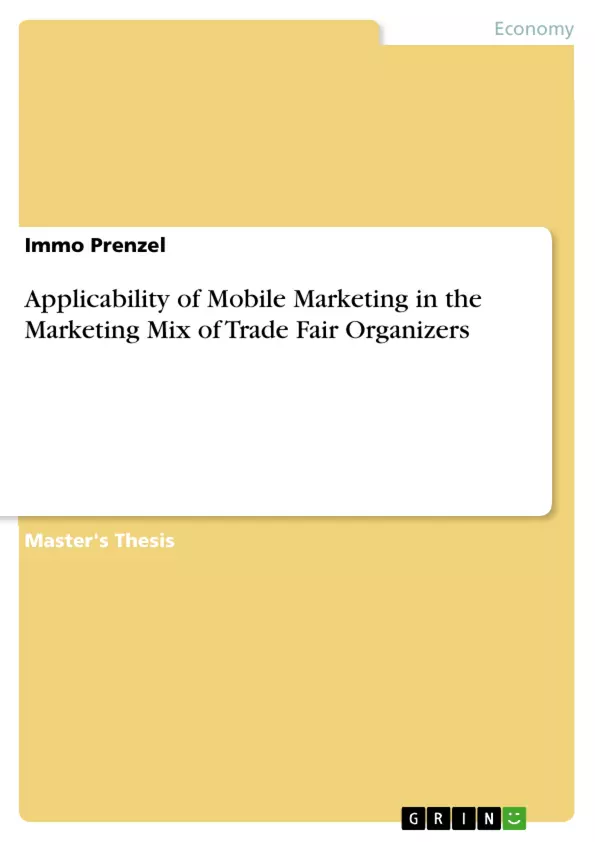Executive Summary
Trade fair organizers face an intensified inter‐ and intra‐industry competition and increasing customer requirements towards efficiency and convenience of the trade fair events. In order to stay competitive trade fair companies have to integrate new market‐oriented marketing measures to improve their customer
communication, extend their service portfolio and thusly satisfy the customer needs. In this context the applicability of mobile marketing in the marketing mix of trade fair organizers was researched in this thesis. It was asserted that mobile marketing is a significant global trend with enormous growth potential as far more people can be reached via the mobile channel than via any other marketing medium. Thereby, mobile marketing is not limited to its communication function but it is understood more comprehensively as the activity, set of institutions, and rocesses for creating, communicating, delivering, and exchanging offerings that have value for customers, clients, partners, and the society at large. The mobile channel offers unique haracteristics that distinguish it from other channels and allow a targeted customer communication. However, there are limitations to mobile marketing that were described within a general framework consisting of technological, legal, customer, organizational and economical aspects. Along this framework the main strategic approaches the push and pull approach were identified. In the following trade fairs and its function, its economy, and participants were introduced. The focus was put on the trade fair organizer as well as on the two most important customer groups, the exhibitors and visitors. Since the applicability of mobile marketing depends on these groups the structure, goals and needs were analyzed thoroughly. It was shown that the success of the event depends on the ability of the trade fair organizer to satisfy the needs of both customer groups simultaneously as they are mutually dependent. Thereby it is important to acquire the right quantity and quality of exhibitors and visitors and provide them with sufficient information before the event as basis for their participation decision. During the event the trade fair organizer must provide a broad service portfolio to support both customer groups to reach their trade fair goals in an efficient manner. After the trade fair tools for customer retention needs to be employed to keep contact with the customers between the events...
Inhaltsverzeichnis (Table of Contents)
- Introduction
- Theory Mobile Marketing
- Introduction: Trends in Mobile Marketing
- Definition and Differentiation of Mobile Marketing
- Characteristics of Mobile Marketing
- Mobile Marketing Instruments
- Goals of Mobile Marketing Campaigns
- Framework for the Application of Mobile Marketing
- Technological Aspects
- Legal Aspects
- Customer Aspects
- Economical and Organizational Aspects
- Mobile Marketing Strategies
- Pull Approach
- Push Approach
- Conclusion and Implications
- Theory Trade Fairs
- Trade Fair Basics
- Definition of Trade Fairs
- Trade Fair Functions
- Participants of the Trade Fair Market
- Trade Fair Organizers
- Exhibitors
- Visitors
- Conclusion and Implications
- Trade Fair Basics
- The Marketing Mix of Trade Fair Organizers
- Definition Marketing Mix
- Policies within the Marketing Mix of Trade Fair Organizers
- Product & Assortment Policy
- Service Policy
- Communication Policy
- Distribution Policy
- Pricing Policy
- Conclusion and Implications
- Integration of Mobile Marketing in the Marketing Mix of Trade Fair Organizers
- Introduction of the Survey: Current application of Mobile Marketing in the Trade Fair Industry
- Applicability of Mobile Marketing in the Marketing Mix
- Applicability of Mobile Marketing in the Product and Assortment Policy
- Applicability of Mobile Marketing in the Service Policy
- Applicability of Mobile Marketing in the Communication Policy
- Applicability of Mobile Marketing in the Distribution Policy
- Assessment of the Applicability of Mobile Marketing within the Marketing Mix of Trade Fair Organizers
- Survey Results: Evaluation of the Importance of the Mobile Marketing Functions for the Trade Fair Marketing
- Evaluation of the Applicability of Mobile Marketing in the Marketing Mix before, during, and after the Trade Fair
- Conclusion and Outlook
- Executive Summary
Zielsetzung und Themenschwerpunkte (Objectives and Key Themes)
This thesis aims to explore the applicability of mobile marketing within the marketing mix of trade fair organizers. The work investigates the current state of mobile marketing within the trade fair industry and analyzes its potential for integration across various marketing mix elements.
- The role of mobile marketing in contemporary marketing strategies.
- The impact of mobile technology on the trade fair environment.
- The potential benefits and challenges of integrating mobile marketing into the marketing mix of trade fair organizers.
- Practical implications and recommendations for the implementation of mobile marketing strategies in the trade fair context.
- A survey-based evaluation of the current usage of mobile marketing by trade fair organizers.
Zusammenfassung der Kapitel (Chapter Summaries)
Chapter 1 provides an introduction to the topic and outlines the research question and objectives. Chapter 2 delves into the theoretical framework of mobile marketing, discussing its definition, characteristics, instruments, goals, and strategies. Chapter 3 presents the theoretical framework of trade fairs, focusing on their definitions, functions, and key participants. Chapter 4 explores the marketing mix of trade fair organizers, defining its elements and discussing the specific policies employed in each area.
Chapter 5 analyzes the potential of mobile marketing for integration into the marketing mix of trade fair organizers, considering its applicability across different marketing mix elements. It includes a survey analysis of the current use of mobile marketing by trade fair organizers.
Schlüsselwörter (Keywords)
This thesis examines the application of mobile marketing within the context of trade fairs. The work explores key concepts like mobile marketing instruments, mobile marketing strategies, and trade fair marketing mix elements. The integration of mobile marketing into the trade fair environment is analyzed through a survey, emphasizing its potential to enhance communication, service delivery, and overall visitor experience.
- Citar trabajo
- Immo Prenzel (Autor), 2009, Applicability of Mobile Marketing in the Marketing Mix of Trade Fair Organizers, Múnich, GRIN Verlag, https://www.grin.com/document/149407



